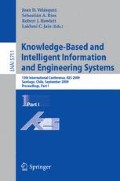Abstract
We investigate the length of event sequence giving best predictions when using a continuous HMM approach to churn prediction from sequential data. Motivated by observations that predictions based on only the few most recent events seem to be the most accurate, a non-sequential dataset is constructed from customer event histories by averaging features of the last few events. A simple K-nearest neighbor algorithm on this dataset is found to give significantly improved performance. It is quite intuitive to think that most people will react only to events in the fairly recent past. Events related to telecommunications occurring months or years ago are unlikely to have a large impact on a customer’s future behaviour, and these results bear this out. Methods that deal with sequential data also tend to be much more complex than those dealing with simple non-temporal data, giving an added benefit to expressing the recent information in a non-sequential manner.
Access this chapter
Tax calculation will be finalised at checkout
Purchases are for personal use only
Preview
Unable to display preview. Download preview PDF.
References
Bilmes, J.: A gentle tutorial on the em algorithm and its application to parameter estimation for gaussian mixture and hidden markov models (1997)
Breiman, L.: Bagging predictors. Machine Learning 24(2), 123–140 (1996)
Chen, Y.-S., Hung, Y.-P., Yen, T.-F., Fuh, C.-S.: Fast and versatile algorithm for nearest neighbor search based on a lower bound tree. Pattern Recogn. 40(2), 360–375 (2007)
Dietterich, T.G.: Machine learning for sequential data: A review. In: Caelli, T.M., Amin, A., Duin, R.P.W., Kamel, M.S., de Ridder, D. (eds.) SPR 2002 and SSPR 2002. LNCS, vol. 2396, pp. 15–30. Springer, Heidelberg (2002)
Duda, R., Hart, P., Stork, D.: Pattern Classification. John Wiley and Sons, Chichester (2001)
Freund, Y., Schapire, R.E.: Experiments with a new boosting algorithm. In: Proceedings of the 13th International Conference on Machine Learning, pp. 148–156. Morgan Kaufmann, San Francisco (1996)
Haddon, J., Tiwari, A., Roy, R., Ruta, D.: Churn prediction: Does technology matter (2006)
Lemmens, A., Croux, C.: Bagging and boosting classification trees to predict churn. Journal of Marketing Research XLIII, 276–286 (2006)
Murphy, K.: A hmm toolbox for matlab, http://www.cs.ubc.ca/~murphyk/software/hmm/hmm.html
Quinlan, J.R.: C4.5: programs for machine learning. Morgan Kaufmann Publishers Inc., San Francisco (1993)
Ruta, D., Nauck, D., Azvine, B.: K nearest sequence method and its application to churn prediction. In: Corchado, E., Yin, H., Botti, V., Fyfe, C. (eds.) IDEAL 2006. LNCS, vol. 4224, pp. 207–215. Springer, Heidelberg (2006)
Wei, C.-P., Chiu, I.-T.: Turning telecommunications call details to churn prediction: a data mining approach. Expert Systems with Applications 23, 103–112 (2002)
Yan, L., Miller, D.J., Mozer, M.C., Wolniewicz, R.: Improving prediction of customer behaviour in non-stationary environments. In: Proc. of Int. Joint Conf. on Neural Networks, pp. 2258–2263 (2001)
Author information
Authors and Affiliations
Editor information
Editors and Affiliations
Rights and permissions
Copyright information
© 2009 Springer-Verlag Berlin Heidelberg
About this paper
Cite this paper
Eastwood, M., Gabrys, B. (2009). A Non-sequential Representation of Sequential Data for Churn Prediction. In: Velásquez, J.D., Ríos, S.A., Howlett, R.J., Jain, L.C. (eds) Knowledge-Based and Intelligent Information and Engineering Systems. KES 2009. Lecture Notes in Computer Science(), vol 5711. Springer, Berlin, Heidelberg. https://doi.org/10.1007/978-3-642-04595-0_26
Download citation
DOI: https://doi.org/10.1007/978-3-642-04595-0_26
Publisher Name: Springer, Berlin, Heidelberg
Print ISBN: 978-3-642-04594-3
Online ISBN: 978-3-642-04595-0
eBook Packages: Computer ScienceComputer Science (R0)

